Two Classes of Christians
One body there is, and one spirit, even as you were called
in the one hope to which you were called; one Lord, one
faith, one baptism; one God and Father of all persons, who
is over all and through all and in all.—Ephesians 4:4-6.
Argumentation is used in an unusual way to deprive persons among Jehovah’s Witnesses of the relationship with God they should rightly have. This is by the teaching of a two-class arrangement for Christians, one class in a definitely more privileged relationship to God than the other. The teaching ultimately serves to support the authority structure in effect within the organization and create a sense of dutiful submissiveness on the part of the membership. What is the essence of this teaching and what forms of argumentation are used to support it?
Among the precious promises made in Scripture as the share of all those turning to God in repentance and placing faith in the ransom sacrifice of his Son are these:
They are set free from slavery to sin and death, are justified or declared righteous in God’s sight, their sins are fully forgiven by the atoning power of Christ’s sacrifice. He acts as their Mediator and brings them into a covenant relationship with his Father, and they are fully reconciled to God and become part of his family, children of God, receiving sonship and the intimate relationship with God this connotes. Life everlasting is theirs, to be lost only
if they lose their faith, since God’s Son states:
- “Most truly I say to you, He that hears my word and believes him that sent me has everlasting life, and he does not come into judgment but has passed over from death to life.” (John 5:24.)
Those are indeed grand promises and present a marvelous relationship with God and his Son. According to the Watch Tower Society’s current teachings, however, those promises and that privileged relationship are today the portion of only some 8,600 persons on earth—the “anointed remnant” of the 144,000 chosen ones. They do not apply to the other four-million-plus persons among Jehovah’s Witnesses. Nor do they apply to any of the five billion other persons on earth who are not Jehovah’s Witnesses. Many of Jehovah’s Witnesses are actually unaware of this fact, not realizing the full extent to which the official teachings of the organization go in this area. Some are frankly disturbed when faced with the fact that—though they themselves have listened to the good news of God, have believed it, have repented and put faith in God’s provision of the ransom sacrifice through his Son—nonetheless, Christ Jesus is not their Mediator; they are not declared righteous and cannot be until the end of the “thousand-year reign of Christ”; hence their sins are not actually forgiven but, as it were, are held in abeyance; that they are not sons of God but only “prospective children,” not becoming truly God’s children until after the “thousand-year period of judgment” and the final test said to follow this. Moreover, they are told (tactfully of course) that the Christian Greek Scriptures or New Testament are written for the “anointed” and do not apply to these other four million persons except “by extension.” This is because they are not part of the 8,600 or so “anointed” ones, those who are to reign with Christ in heaven and who alone partake of the bread and wine at the Lord’s evening meal. These teachings have not gone completely unquestioned. Because of questions about the Scripturalness of this two-tier relationship of the “anointed” and the “other sheep” class, the organization has prepared a number of articles designed to strengthen belief in those points of the teaching that are most tenuous. The argumentation employed again merits attention.
The “Other Sheep”
The designation “other sheep,” found at John 10:16, is part of the issue. Jesus’ words there are:
- “And I have other sheep, which are not of this fold; those also I must bring, and they will listen to my voice, and they will become one flock, one shepherd.”
The Watch Tower’s teaching is that by this expression “other sheep” Jesus referred to those not part of the 144,000 “anointed” ones, to a class with an earthly destiny.
When I was talking with a respected member of the Branch Committee of a major European country, this text came up in the conversation. At the mere reference to it, and with no comment from me or any previous discussion of it, he immediately said: “That obviously applies to the Gentiles.”
In one Governing Body session, this topic came up for discussion and I mentioned that I had heard several persons express themselves in line with the comment just quoted. After some discussion, the motion at the close was to hold to the traditional position. During the discussion, Ted Jaracz gave a notable example of circular reasoning by asking ‘where the earthly class would appear in the parable if this expression did not apply to them?’ Actually, as Jaracz well knows, the “earthly class” are consistently excluded in the Watch Tower publications from all Jesus’ parables except this one and that of the sheep and goats (Matthew 25:31-46). Just before the vote was called for, member Leo Greenlees said, “Doesn’t it seem that we should at least allow for the possibility of the text’s applying to the Gentiles?” But no such allowance was made.
Yet the parable clearly first describes Jesus’ ministry to the Jewish people, those in the “sheep pen” of Israel, to which he came and from which he called forth those who proved to be “his sheep,” those who knew his voice and followed it. Since he clearly first called his sheep from among the Jews, who would the “other sheep” logically be but those among the Gentiles who subsequently heard his voice, expressed through his apostles and disciples? John 10:1-16; compare John 1:11-13; Matthew 10:16; 15:24; 28:18-20; Acts 1:8.
The July 15, 1980, Watchtower (page 23) sought to dispel doubts about the traditional teaching on this subject, a teaching in effect since about 1921. Note the manner in which it introduces the opposing view that this text refers to the Gentiles, as those to be joined to the fold of Jewish Christians and with them become “one flock”:
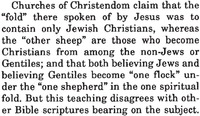
A “red herring” is immediately introduced by the attribution of this understanding of John 10:16 to “the churches of Christendom,” as though these are the original source of the view that the “other sheep” in the text relates to the Gentiles. This has a very predictable effect on the minds of the Witness reader, one stimulating the bias of “provincialism.” Since Christendom is viewed as a major part of “Babylon the Great,” hence an anathema, the view is tarred from the start by such prejudice. This is also described in the field of logic as a “poisoning the well” tactic, in which an effort is made to discredit the source so as to make it appear that any evidence or argument from that source is not worthy of serious consideration.
Clear thinking should make plain that it is false reasoning to claim that simply because something is believed by such churches it automatically should be viewed as suspect, even automatically erroneous. Christendom, certainly a major part of it, likewise teaches that Christ is mankind’s savior, that he died for mankind; most of Christendom’s churches teach that God’s Word is found in the Bible, that it provides divine guidance for mankind, points the way to everlasting life. Does their being taught by Christendom’s churches make such teachings wrong or suspect? The Watch Tower organization has never hesitated to quote from
Bible dictionaries, Bible commentaries, lexicons and other such works that are the product of scholars within Christendom whenever their statements can be used in support of the organization’s teachings. As but one example, the January 15, 1991, Watchtower in just six pages (pages 10 to 15) quotes from fifteen sources in support of its position—all of them from “Christendom.” Generally, when a quotation favorable to a Watch Tower position is employed, no attention is drawn to the fact that the source—whether a Bible dictionary or commentary or other religious work—is a product of what the Watchtower terms “apostate Christendom,” and the author of the favorable material is either simply named or is designated, not as a representative of “Babylon the Great,” but as “a Biblical scholar” or similar term. Only when those statements run contrary to Watch Tower dogma is there the inconsistent type of appeal to bias exemplified in this article. The course of honesty is to recognize that an argument stands or falls on its own merit, irrespective of its source.
The attempt is soon made to place the reader on “the horns of a false dilemma,” by saying that “this teaching disagrees with other Bible scriptures bearing on the subject.” But this statement is mere assertion and is without foundation. Let us assume for the sake of argument that all the other teachings of the organization about the literalness of the number 144,000, about others outside that number being destined for life in an earthly paradise, about the sheep in the parable of the sheep and goats as relating to those who will live in the earthly paradise—let us assume that all this is correct. How does that in any way argue against Jesus’ having referred to the Gentiles in the text under discussion, John 10:16? It simply does not.
Is it not true that the converts among the Gentiles did in fact become united with the Jewish Christians as one flock under one Shepherd? Whether the teachings of the organization about an earthly class are true or not would not change this fact in the least, would it? Since such ‘listening to the voice of Jesus’ by Gentiles and their being joined to the flock of Jewish Christians did actually occur, what prevents Jesus’ illustration from applying in that way? What just reason is there for attempting to force a “confrontation” between such Biblical understanding and the teachings of the organization about an earthly class and an earthly paradise, when no such confrontation or opposition is required? If the argument were solid and rested on sound Scriptural evidence, there would be no need for the writer of the article to resort to the use of a false dilemma. The Watchtower’s argumentation is neither fair nor factual.
The following paragraph suggests to the reader what John “could well have called to mind” when writing down Jesus’ words. Having referred to the parable of the sheep and goats at Matthew 25, it says:
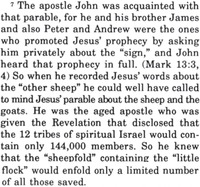
The Watchtower, July 15, 1980, page 23.
This attempt by the writer of the article at what amounts to mind-reading proves nothing; it is also pointless, since the words at John 10:16, did not originate with John’s thinking but with that of Jesus. The statement also presumes that John understood the 144,000 in Revelation as the Watch Tower organization understands it. Once again, the writer argues by use of circular reasoning.
Perhaps the most interesting feature of the articles is the picture drawn to portray in graphic form the Watch Tower interpretation of the text, as shown on the following page
Although this is, admittedly, only an artist’s sketch, the concept the scene conveys, designed to harmonize with the organization’s teaching, is almost incredible.
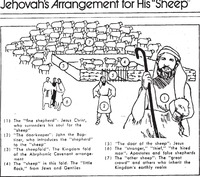
Here is depicted an Israelite shepherd with seven sheep (by count) protected in a pen and fifty others (by count) left loose outside and without the protection of the pen. What shepherd in any time of history, in any race, in any country of the world, would have such an arrangement of his sheep? What shepherd would gain “other sheep” in large numbers and leave them disconnected, walled off from his existing flock, milling around outside the sheepfold? Even
if it were a case of two distinct breeds of different quality or type of wool, the shepherd would still at least provide a sheep pen for the added breed. But are there really two “breeds” of Christians in any sense that would make for the unequal treatment depicted in the Watchtower picture?
Notably, the artist chose a ratio of about 7 sheep outside to every one inside. If the ratio were based on the more than 4,000,000 Witnesses now supposedly of the “other sheep” class as compared with the total of 144,000 of the so-called “little flock” the ratio would actually be closer to 28 to 1. That would mean that if 7 sheep are depicted inside the pen, there would be 196 outside, which would make the scene all the more incredible.
In the first century, at Pentecost 3,000 persons were baptized. Later the account refers to “five thousand men” as among those accepting the good news (Acts 2:41; 4:4.). In the years that followed, not only was there further growth in Jerusalem, but congregations of believers developed throughout the then known world, and historical evidence indicates that the number of those embracing the good news reached into the many tens, even hundreds, of thousands. Compare Acts 6:1, 7; 8:1, 4, 5, 14; 13:44, 48, 49; Matthew 28:18-20; Acts 1:8. Even if we were to assume that the greater number did not prove faithful, still it is difficult to believe that there were not at the very least thousands who did. Since the Watchtower magazine began to be published in 1879, more tens of thousands have professed to be anointed followers of Christ and the Watchtower certainly implies that many of these proved faithful. For the purpose of illustration, if we were to accept a very conservative figure of 10,000 proving faithful to death during the course of the first century, and another 10,000 from 1879 onward, that would leave (according to Watch Tower doctrine) 124,000 others to be approved — during the intervening period—as heavenly heirs. Consider what that would mean. It would mean that during the ensuing 1,779 years before the Watch Tower organization comes on the scene, Christ Jesus, who was directing his followers in accord with his words at Matthew 28:20, only saw an average of 70 persons a year—in the whole world—become faithful and approved followers of his! This figure results from dividing 124,000 by 1,779 (years). Surely it strains belief to think that such paltry results would come from Jesus’ direction of his disciples, and it is demeaning to the power of the good news and the power of God’s holy Spirit.
Despite all the intricate argumentation, it seems evident that a true Christian is a true Christian. The inspired Scriptures themselves plainly know and present no other kind. All who hear the good shepherd’s voice are called on to show the same kind of faith and love, the same fruitage of God’s Spirit, enjoying the same relationship with Him as sons. Two differing kinds of Christian “sheep” is the product of human invention.
Right within the Bible we find a passage that remarkably parallels that of John 10:16, namely what the apostle Paul wrote at Ephesians 2:11-18. There, in place of two groups of sheep, the apostle refers to two peoples, Jews and Gentiles, and says, according to the New World Translation:
- “Therefore keep bearing in mind that formerly you were people of the nations as to the flesh: “uncircumcision” you were called by that which is called “circumcision” made in the flesh with hands— that you were at that particular time without Christ, alienated from the state of Israel and strangers to the covenants of the promise, and you had no hope and were without God in the world. But now in union with Christ Jesus you who were once far off have come to be near by the blood of the Christ. For he is our peace, he who made the two parties one and destroyed the wall in between that fenced them off. By means of his flesh he abolished the enmity, the Law of commandments consisting in decrees, that he might create the two peoples in union with himself into one new man and make peace; and that he might fully reconcile both peoples in one body to God through the torture stake, because he had killed off the enmity by means of himself. And he came and declared the good news of peace to you, the ones far off, and peace to those near, because through him we, both peoples, have the approach to the Father by one spirit.”
All the elements found in John 10:16, are found here. Though it uses a different analogy from that of sheep, it says the same thing, presents the same picture. It shows that, in addition to the Jewish believers (or sheep) the Gentile believers (or sheep) heard the good news (the voice of the shepherd, Christ), and through Christ the two peoples were made into one body (or one flock), under him as their head (their one shepherd).
To say, then, that understanding the “other sheep” in John 10:16, as relating to the Gentile believers, “disagrees with other Bible scriptures bearing on the subject” is exactly opposite to the facts. That understanding is totally harmonious, not only with Paul’s statement just quoted, but with all the rest of the Scriptures. From the time of God’s promise to Abraham forward, the Scriptures continually pointed forward to and prophesied of the time when God would join people of all nations into one people, his people under his Messiah.34 Seen against that background Jesus’ statement is easily understood, with no complicated, intricate arguments needed to explain it. Rather than being in ‘disharmony with scriptures bearing on the subject,’ in view of all the prophecies pointing to this, it would be most unusual if Jesus had not given a parable illustrating the entry of Gentiles into unity with Jewish believers.
Another designation used for the claimed secondary class of Christians is that of the “great crowd,” a term drawn from Revelation 7:9-17. For a consideration of this subject, the reader is referred to the Appendix.
In their teaching regarding two classes of Christians, the Watch Tower Society relies strongly on the account at Revelation chapter 7. They apply John’s vision of 144,000, “sealed out of every tribe of the sons of Israel,” to the “anointed class” or “spiritual Israel.” Verses 9 through 17, which describe a “great crowd . . . out of all nations and tribes and peoples and tongues,” are applied to an earthly class who are, in effect, “spiritual Gentiles.” (See for example Paradise Restored to Mankind—By Theocracy!, page 80, paragraph 15.) It is of interest to compare the things said of this “great crowd” with Scriptural texts which the organization explicitly applies to the “anointed class” or that clearly relate to heavenly beings. That comparison reveals very similar or even identical descriptions. Here are some examples:
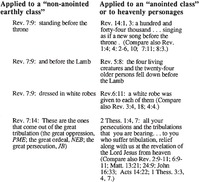
- | - | - |-
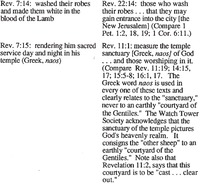
With regard to the 144,000 in this chapter of Revelation, the account speaks of these as “sealed out of every tribe of the sons of Israel,” 12,000 out of each of the 12 tribes (verses 4-8). Watch Tower publications view the “sons of Israel” to be such, not in a literal, but in a figurative sense, as part of a spiritual Israel. They view the 12 “tribes” similarly, not as literal tribes but as figurative tribes. In view of that, any selecting “twelve thousand” persons out of twelve “tribes” could likewise not be literal, but figurative. The question then is, how can the addition of all these figurative elements produce a literal total or sum, namely a literal 144,000? The Watch Tower Society’s argument is that since the “great crowd” is described as one that “no man was able to number,” hence indefinite as to number, then the 144,000 must be a definite and literal number. Yet when explaining the significance of the “twenty-four older persons” referred to in related passages of Revelation, they state that this figure of 24 is not literal but is symbolic of the full number of those who reign with Christ in heaven. (See Revelation 4:4, 10; 5:8; 11:16; 19:4. See also Revelation — Its Grand Climax At Hand!, page 77.) In Revelation there are references to the 7 spirits (1:4), the 7 stars (1:16), the 10 days (2:10), the 24 thrones and 24 elders and 7 lamps (4:4, 5) the 4 living creatures (4:6, 7), the 7 horns and 7 eyes of the Lamb (5:6, the fourth part of the earth (6:8), the 4 angels and the 4 corners of the earth (7:1), the third part of the trees, creatures and rivers, etc. (8:7-12), and many, many other numerical figures employed, which are presented in Watch Tower publications as being, not literal, but figurative, symbolic. Why then should not the 144,000 be viewed in the same light?
For these reasons some understand the 144,000 to be a symbolic number representing an ideal figure, the complete sum of all those who become spiritual Israelites, no matter how many they may prove to be. The “great crowd” could, in such case, simply represent the same ones, but seen from the viewpoint of the reality, the fulfillment of the symbolic ideal represented by the 144,000.